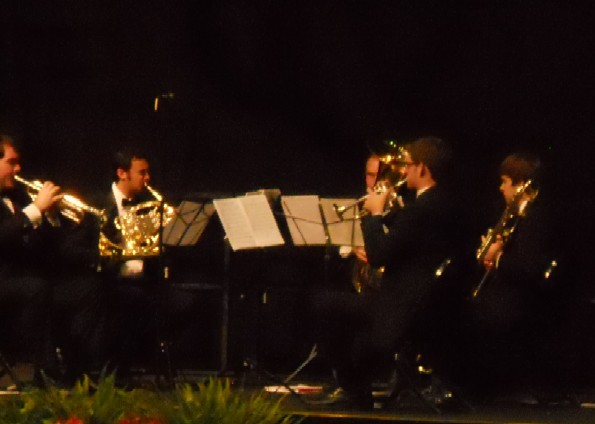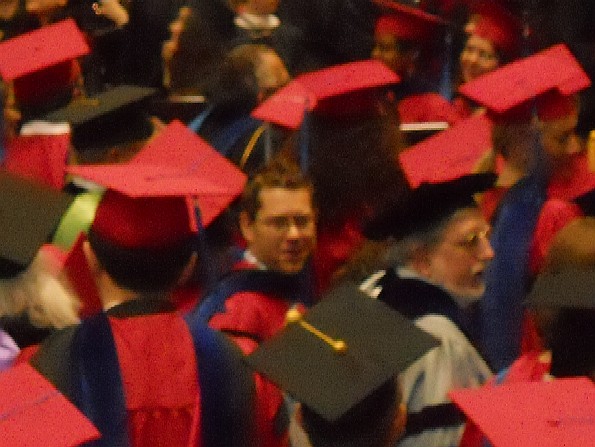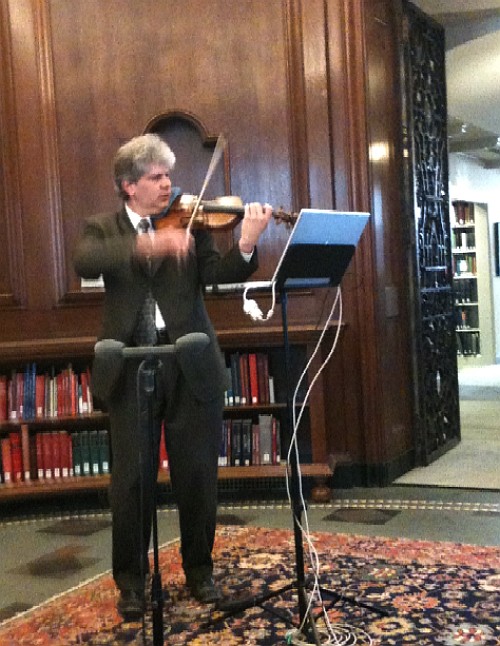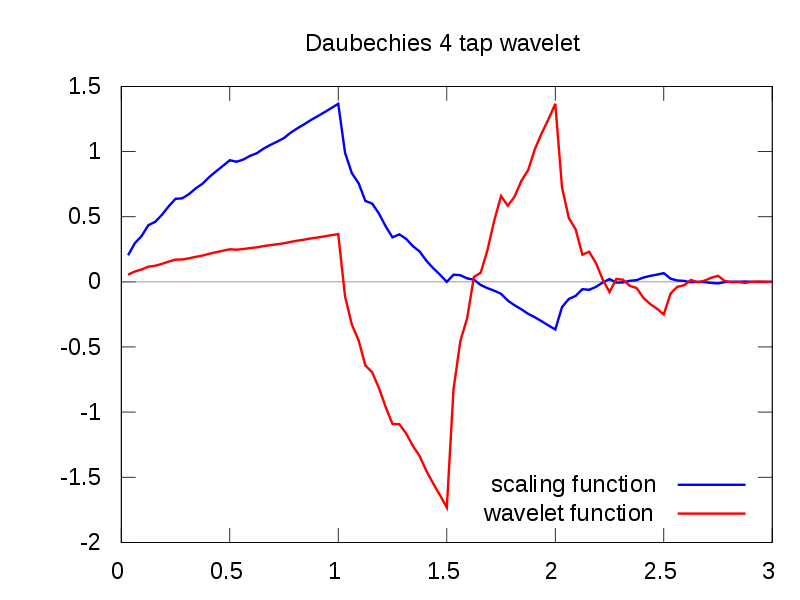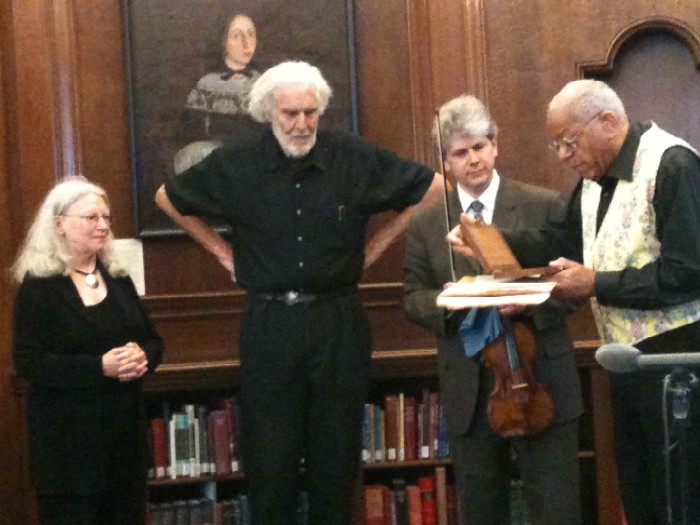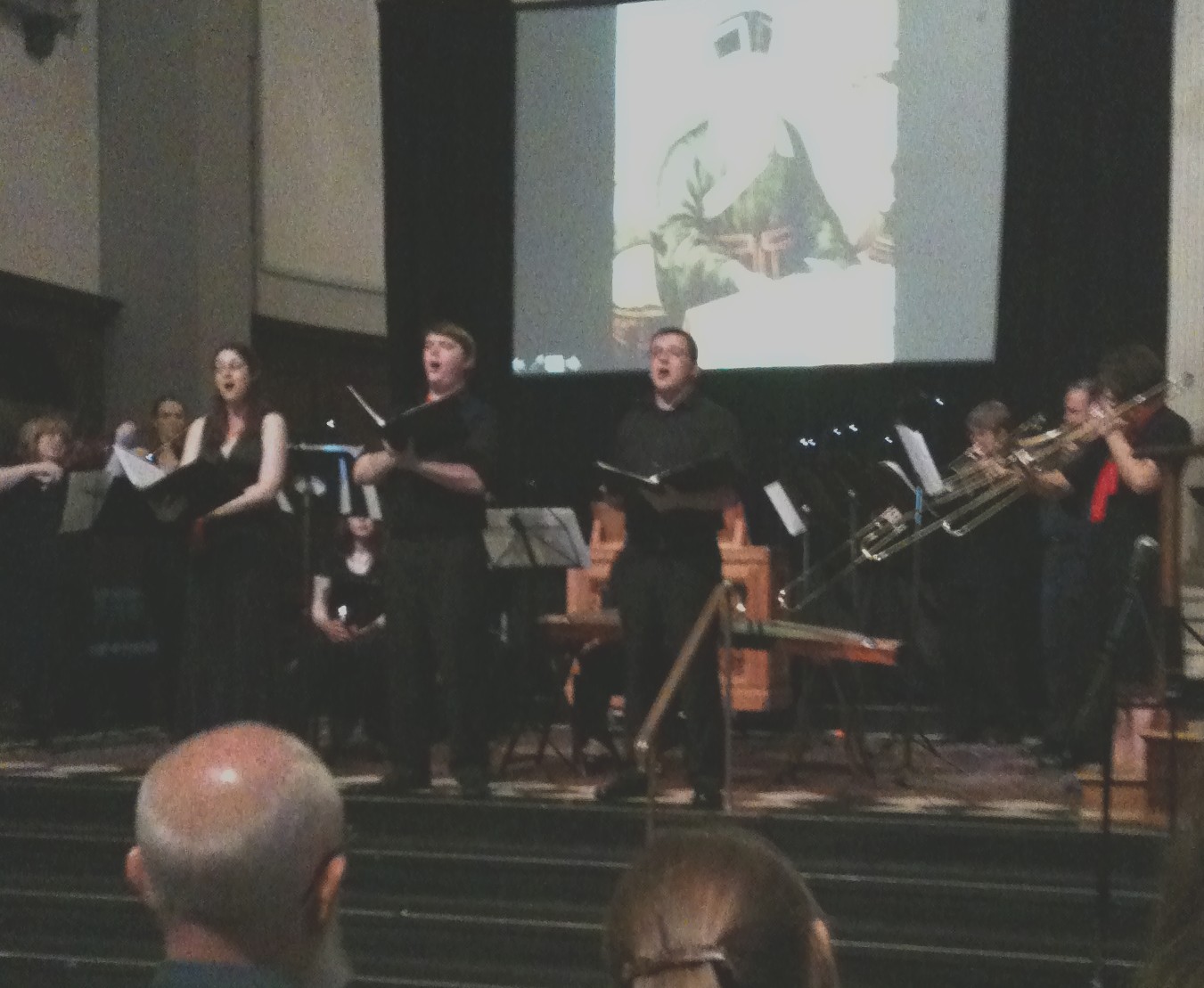
J ust as western countries have never heard the teaching of the sages of China, so we Chinese have never heard of the books of their ancient sages. Both now enlighten each other; both benefit one another.”
— Feng Yingjing, acquaintance of Fr. Matteo Ricci, 16th-Century China.
S acabuche! is an ensemble of Chinese and western instruments and voices directed by Linda Pearse. Sacabuche! performed a series of concerts and workshops in Beijing, China, in December, 2010, and yesterday at BEMF in Boston offered a multimedia performance of their work about the Italian Jesuit priest (and mathematician, scientist, cartographer, and all-around polymath), Matteo Ricci, whose decades spent in China in the late 16th century resulted in the first map in Chinese. Ricci’s detailed map, completed and presented to the Wanli Emperor in 1602, showed the entire world—eastern and western hemispheres—surprising and edifying both the Chinese and the Italians.
I U Jacobs School of Music faculty members Stanley Ritchie and Wendy Gillespie contributed to the collaboration, as did University of Minnesota professor of History, Ann Waltner. The performance combined historical readings with early music from both sixteenth- and seventeenth-century Europe and China, along with new compositions by Oberlin/Juilliard-trained now-New-York-based composer
Huang Ruo, commissioned for the Sacabuche! project.
T he multimedia performance reanimates the seminal political and cultural exchange between Italian Jesuits and Chinese literati in 16th/17th-century China and unifies (1) Italian music of Ricci’s Italy performed on period instruments, (2) Chinese music of Ricci’s China performed on traditional Chinese instruments, (3) Huang Ruo’s new music, (4) dramatic readings, and (5) historical imagery, including a projected digitized version of Ricci’s map (an old original, James Ford Bell Library, U of M) Chinese paintings and calligraphy and other artworks.
- Linda Pearse, artistic director & sackbut
- Ann Waltner, co-director, speaker, author of program notes/script
- Qin Fang, speaker
- Yang Yi, guzheng
- Carrie Tsujui Chin, sheng
- Eunji Lee, piano and organ
- Sarah Barbash-Riley, Ray Horton & François Godère, sackbut
- Martie Perry & Janelle Davis, Baroque violin
- Wendy Gillespie, viola da gamba
- Elise Figa, soprano
- Andrew Rader, countertenor
- Benjamin Geier, tenor
- Huang Ruo, composer
- Cathy Barbash, producer
T he thoughtful selection of 16th-Century Chinese imagery alternating with Italian Baroque Catholic Church imagery was accompanied by short descriptive and poetical Chinese and English texts read by Qin Fang and by Ann Waltner, respectively, interleaved with the Chinese and Italian Baroque music. The pace and the variety of sonic textures were really exciting—informing those of us who do not know very much about Chinese or Jesuit history; capturing and holding our interest throughout; and inspiring our expanding wonder about what the decades-long contact that Fr. Ricci and his Chinese hosts had with each other really entailed.
H uang Ruo’s “Fisherman’s Sonnet” is patterned after
kun opera but includes a number of exotic orchestrations of Chinese and western instruments that have probably never been heard playing together before (sackbuts! viola da gamba! Baroque organ! with sheng and guzheng!).
C arrie Tsujui Chin’s sheng playing and Yang Yi’s guzheng were masterful and incisive—at times forcefully and at other times poignantly and delicately contrasting with the rest of the ensemble’s Baroque Italian harmonies.
- Huang Ruo – Fisherman’s Sonnet
- A. Gabrieli – Benedictus Dominus Deus Sabaoth
- A. Gabrieli – Ricercar
- A. Gabrieli – Alla Battaglia
- Anon. – Tianfeng huanpei (Jade Pendants of the Immortals)
- G. Palestrina – Quan pulchri Sunt
- G. Nanino – Amor m’ha posto; I pensier so saette
- G. Palestrina – Nigra sum, sed formosa
- Bartolomeo de Selma – Vestiva i colli
- G. Palestrina – Vestiva i colli
- Anon. – Gaoshan liushui (Lofty Mountains and Rolling Waters)
- A. Gabrieli – Ricercar arioso
- G. Palestrina – Surgam et circuibo civitatem
- Huang Ruo – My Promises are Above
 T
T he readings were graceful and passionately delivered. Some of the readings are excerpts from Ricci’s diaries and letters—poetical in their own way and manifesting not so much the worldview of a missionary of the Roman Catholic Church as the personal and good-hearted expressions of a human being who is deeply and continually interested in other people and how they live, continually interested in learning, and in Life. Over his 30+ years in China, Ricci was fluent in writing and speaking Chinese and came to be highly regarded by the local Chinese scholars with whom he came into contact.
R icci [Li Xitai] … there is not a single one of our books that he has not read… In a noisy gathering of several dozen people with everybody speaking at once, the arguments he is following do not disturb him at all… [Other people] err through an excess of either inflexibility or compliancy… they are all inferior to him.”
— Li Zhi, letter to a friend regarding Ricci, 1600.
I f one totes up the durations of the various segments of the performance, the Chinese texts and music occupy considerably less time than the Baroque western music and Ricci texts. This is, after all, a production about Ricci and his activity and travels and his map. But the Chinese material is not merely ‘context’ or ‘backdrop’ for the Ricci saga; it is aesthetically and expressively as strong as the rest. The guzheng and sheng music is, if anything, revealing of a greater depth of existential reflection and contemplation on the part of the Chinese—of a great intellectual openness and spiritual preparedness to receive whatever insights a new experience [with Ricci, or with others] might offer—contrasted with the still-transcendent-but-more-constrained conceptions of Gabrieli or Palestrina. From the performance, we get the strong message that the illustrious Chinese Ricci encountered and whose writings survive were extraordinary human beings, every bit as much as Ricci was extraordinary.
T here are, naturally, other, less sanguine perspectives on Ricci and his accomplishments (see some of the books linked below). Indeed, some of Huang Ruo’s music conveys the diversity of Chinese opinion about the Jesuit(s) in their midst. Ricci’s chronic reluctance to forthrightly state what his or the Church’s purposes and intentions were in China evidently wore thin at times—graciousness has its limits, and there has to be an acceptable bilateral flow of value, or convincing and ongoing prospects of future value flow, for the relationship/exchange/intrusion to be sustainable. Huang Ruo’s music and the ensemble’s playing provide a balanced and empathetic, speculative account of this cross-cultural give-and-take. This is not surface-level alternating now-Chinese-now-Western-sacred-music collage or ‘documentary’; instead, the dramatic tension of the work derives from the fact that the sequence of compositions does recreate this diversity, this give-and-take, complete with the politics and misapprehensions in it. Not inscrutable! Quite the opposite.
M any thanks to the IU and U of M for producing and performing this beautiful and exciting work! International Relations par excellence!

- Linda Pearse at IU Jacobs School of Music ... Mount Allison Univ, NB
- Sacabuche page at IU Jacobs School of Music
- Huang Ruo website [Future in REverse]
- Billings T, tr. Ricci: On Friendship: One Hundred Maxims for a Chinese Prince. Columbia Univ, 2009.

- Brockey L. Journey to the East: The Jesuit Mission to China, 1579–1724. Harvard/Belknap, 2008.

- Fontana M. Matteo Ricci: A Jesuit in the Ming Court. Rowan & Littlefield, 2011.

- Hsia F. Sojourners in a Strange Land: Jesuits and Their Scientific Missions in Late Imperial China. Univ Chicago, 2009.

- Hsia R Po-chia. A Jesuit in the Forbidden City: Matteo Ricci, 1552-1610. Oxford Univ, 2010.

- Huo A. Lettres à Matteo Ricci. Bayard, 2010.

- Laven M. Mission to China: Matteo Ricci and the Jesuit Encounter with the East. Faber & Faber, 2011.

- Mungello D. Curious Land: Jesuit Accommodation and the Origins of Sinology. Univ Hawaii, 1989.

- Parker C. Global Interactions in the Early Modern Age, 1400-1800. Cambridge Univ, 2010.

- Ross A. A Vision Betrayed: The Jesuits in Japan and China, 1542-1742. Orbis, 2003.

- Spence J. The Memory Palace of Matteo Ricci. Penguin, 1985.

- Chiang Ching-kuo Foundation
- Intl Society for the Performing Arts (ISPA) [Cathy Barbash, et al.]
- Cathedral Church of St. Paul (Episcopal; Chinese Boston Ministry)










